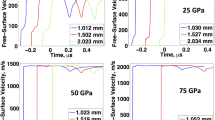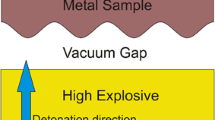Abstract
Hydrodynamic instability experiments allow access to material properties at extreme conditions, where strain rates exceed 105 s−1 and pressures reach 100 GPa. Current hydrodynamic instability experimental methods require in-flight radiography to image the instability growth at high pressure and high strain rate, limiting the facilities where these experiments can be performed. An alternate approach, recovering the sample after loading, allows measurement of the instability growth with profilometry. Tantalum samples were manufactured with different 2D and 3D initial perturbation patterns and dynamically compressed by a blast wave generated by laser ablation. The samples were recovered from peak pressures between 30 and 120 GPa and strain rates on the order of 107 s−1, providing a record of the growth of the perturbations due to hydrodynamic instability. These records are useful validation points for hydrocode simulations using models of material strength at high strain rate. Recovered tantalum samples were analyzed, providing an estimate of the strength of the material at high pressure and strain rate.















Similar content being viewed by others
References
Asphaug E, Agnor CB, Williams Q (2006) Hit-and-run planetary collisions. Nature 439(7073):155–160. https://doi.org/10.1038/nature04311
Canup RM, Asphaug E (2001) Origin of the Moon in a giant impact near the end of the Earth’s formation. Nature 412(6848):708–712. https://doi.org/10.1038/35089010
Senft LE, Stewart ST (2007) Modeling impact cratering in layered surfaces. J Geophys Res: Planets 112(E11):E11002. https://doi.org/10.1029/2007JE002894
Rudd RE, Germann TC, Remington BA, Wark JS (2010) Metal deformation and phase transitions at extremely high strain rates. MRS Bull 35(12):999–1006. https://doi.org/10.1557/mrs2010.705
Rittel D, Bhattacharyya A, Poon B, Zhao J, Ravichandran G (2007) Thermomechanical characterization of pure polycrystalline tantalum. Mater Sci Eng A 447(1–2):65–70. https://doi.org/10.1016/j.msea.2006.10.064
Duprey KE, Clifton RJ (2000) Pressure-shear response of thin tantalum foils. AIP Conf Proc 505(1):447–450. https://doi.org/10.1063/1.1303512
Preston DL, Tonks DL, Wallace DC (2003) Model of plastic deformation for extreme loading conditions. J Appl Phys 93(1):211–220. https://doi.org/10.1063/1.1524706
Barton NR, Bernier JV, Becker R, Arsenlis A, Cavallo R, Marian J, Rhee M, Park HS, Remington BA, Olson RT (2011) A multiscale strength model for extreme loading conditions. J Appl Phys 109(7):073501. https://doi.org/10.1063/1.3553718
Richtmyer RD (1960) Taylor instability in shock acceleration of compressible fluids. Commun Pure Appl Math 13(2):297–319. https://doi.org/10.1002/cpa.3160130207
Meshkov EE (1969) Instability of the interface of two gases accelerated by a shock wave. Fluid Dyn 4(5):101–104. https://doi.org/10.1007/BF01015969
Taylor G (1950) The instability of liquid surfaces when accelerated in a direction perpendicular to their planes I. Proc R Soc Lond A 201(1065):192–196. https://doi.org/10.1098/rspa.1950.0052
Piriz AR, López Cela JJ, Tahir NA, Hoffmann DHH (2008) Richtmyer-Meshkov instability in elastic-plastic media. Phys Rev E 78(5):056401. https://doi.org/10.1103/PhysRevE.78.056401
Piriz AR, Cela JJL, Cortázar OD, Tahir NA, Hoffmann DHH (2005) Rayleigh-Taylor instability in elastic solids. Phys Rev E 72(5):056313. https://doi.org/10.1103/PhysRevE.72.056313
Jacobs JW, Catton I (1988a) Three-dimensional Rayleigh-Taylor instability Part 2. Experiment. J Fluid Mech 187:353–371. https://doi.org/10.1017/S0022112088000461
Jacobs JW, Catton I (1988b) Three-dimensional Rayleigh-Taylor instability Part 1. Weakly nonlinear theory. J Fluid Mech 187:329–352. https://doi.org/10.1017/S002211208800045X
Wilkinson JP, Jacobs JW (2007) Experimental study of the single-mode three-dimensional Rayleigh-Taylor instability. Phys Fluids (1994-present) 19(12):124102
Marinak MM, Remington BA, Weber SV, Tipton RE, Haan SW, Budil KS, Landen OL, Kilkenny JD, Wallace R (1995) Three-dimensional single mode Rayleigh-Taylor experiments on Nova. Phys Rev Lett 75(20):3677–3680. https://doi.org/10.1103/PhysRevLett.75.3677
Goncharov VN (2002) Analytical model of nonlinear, single-mode, classical Rayleigh-Taylor instability at arbitrary Atwood Numbers. Phys Rev Lett 88(13):134502. https://doi.org/10.1103/PhysRevLett.88.134502
Chapman PR, Jacobs JW (2006) Experiments on the three-dimensional incompressible Richtmyer-Meshkov instability. Phys Fluids (1994-present) 18(7):074101. https://doi.org/10.1063/1.2214647
Barnes JF, Blewett PJ, McQueen RG, Meyer KA, Venable D (1973) Taylor instability in solids. J Appl Phys 45(2):727–732. https://doi.org/10.1063/1.1663310
Barnes JF, Janney DH, London RK, Meyer KA, Sharp DH (1980) Further experimentation on Taylor instability in solids. J Appl Phys 51(9):4678–4679. https://doi.org/10.1063/1.328339
Lebedev AI, Nisovtsev PN, Rayevsky VA (1993) Rayleigh-Taylor instability in solids. Proceedings of the 4th international workshop on the physics of compressible turbulent mixing. Cambridge University Press, Cambridge, p 81
Kalantar DH, Remington BA, Colvin JD, Mikaelian KO, Weber SV, Wiley LG, Wark JS, Loveridge A, Allen AM, Hauer AA, Meyers MA (2000) Solid-state experiments at high pressure and strain rate. Phys Plasmas (1994-present) 7(5):1999–2006. https://doi.org/10.1063/1.874021
Park HS, Lorenz KT, Cavallo RM, Pollaine SM, Prisbrey ST, Rudd RE, Becker RC, Bernier JV, Remington BA (2010) Viscous Rayleigh-Taylor instability experiments at high pressure and strain rate. Phys Rev Lett 104(13):135504. https://doi.org/10.1103/PhysRevLett.104.135504
Park HS, Rudd R, Cavallo R, Barton N, Arsenlis A, Belof J, Blobaum K, El-dasher B, Florando J, Huntington C, Maddox B, May M, Plechaty C, Prisbrey S, Remington B, Wallace R, Wehrenberg C, Wilson M, Comley A, Giraldez E, Nikroo A, Farrell M, Randall G, Gray G (2015) Grain-size-independent plastic flow at ultrahigh pressures and strain rates. Phys Rev Lett 114(6):065502. https://doi.org/10.1103/PhysRevLett.114.065502
Prime MB, Buttler WT, Buechler MA, Denissen NA, Kenamond MA, Mariam FG, Martinez JI, Oró DM, Schmidt DW, Stone JB, Tupa D, Vogan-McNeil W (2017) Estimation of metal strength at very high rates using free-surface Richtmyer-Meshkov instabilities. J Dyn Behav Mater. https://doi.org/10.1007/s40870-017-0103-9
Maddox BR, Park HS, Lu CH, Remington BA, Prisbrey S, Kad B, Luo R, Meyers MA (2013) Isentropic/shock compression and recovery methodology for materials using high-amplitude laser pulses. Mater Sci Eng A 578:354–361. https://doi.org/10.1016/j.msea.2013.04.050
Chandrasekhar S (2013) Hydrodynamic and hydromagnetic stability. Courier Corporation, New York
Brouillette M (2002) The Richtmyer-Meshkov instability. Annu Rev Fluid Mech 34(1):445–468. https://doi.org/10.1146/annurev.fluid.34.090101.162238
Randall GC, Vecchio J, Knipping J, Wall D, Remington T, Fitzsimmons P, Vu M, Giraldez EM, Blue BE, Farrell M, Nikroo A (2013) Developments in microcoining rippled metal foils. Fus Sci Technol 63(2):274–281
Barker LM, Hollenbach RE (1972) Laser interferometer for measuring high velocities of any reflecting surface. J Appl Phys 43(11):4669–4675. https://doi.org/10.1063/1.1660986
Celliers PM, Bradley DK, Collins GW, Hicks DG, Boehly TR, Armstrong WJ (2004) Line-imaging velocimeter for shock diagnostics at the OMEGA laser facility. Rev Sci Instrum 75(11):4916–4929. https://doi.org/10.1063/1.1807008
Larsen JT, Lane SM (1994) HYADES–a plasma hydrodynamics code for dense plasma studies. J Quant Spectrosc Radiat Transf 51(1–2):179–186. https://doi.org/10.1016/0022-4073(94)90078
McGlaun JM, Thompson SL, Elrick MG (1990) CTH: a three-dimensional shock wave physics code. Int J Impact Eng 10(1):351–360. https://doi.org/10.1016/0734-743X(90)90071-3
Bennett BI, Johnson JD, Kerley GI, Rood GT (1978) Recent developments in the Sesame equation-of-State Library. Technical report LA-7130, Los Alamos Scientific Laboratory, New Mexico
Marsh SP (1980) LASL Shock Hugoniot data. University of California Press, Berkeley
Steinberg DJ, Cochran SG, Guinan MW (1980) A constitutive model for metals applicable at high-strain rate. J Appl Phys 51(3):1498–1504. https://doi.org/10.1063/1.327799
Steinberg DJ (1996) Equation of state and strength properties of selected materials. Technical Report UCRL-MA-106439 (change 1), Lawrence Livermore National Laboratory, CA (USA)
Acknowledgements
This work was performed under the auspices of the US Department of Energy by Lawrence Livermore National Security, LLC, Lawrence Livermore National Laboratory under Contract No. DE-AC52-07NA27344. This work was supported by the NNSA through the HEDLP program, Grant Numbers DE-NA0001805 and DE-NA0001832. Experimental time was awarded by the Jupiter Laser Facility at Lawrence Livermore National Laboratory. We would like to thank the staff at the Jupiter Laser Facility for their help during our experimental campaign. The experiment was completed with the help of Professor Marc Meyers, Tané Remington, and Shiteng Zhao of the University of California, San Diego and Suzanne Ali of the University of California, Berkeley.
Author information
Authors and Affiliations
Corresponding author
Rights and permissions
About this article
Cite this article
Sternberger, Z., Maddox, B., Opachich, Y. et al. Inferring Strength of Tantalum from Hydrodynamic Instability Recovery Experiments. J. dynamic behavior mater. 4, 244–255 (2018). https://doi.org/10.1007/s40870-018-0153-7
Received:
Accepted:
Published:
Issue Date:
DOI: https://doi.org/10.1007/s40870-018-0153-7




